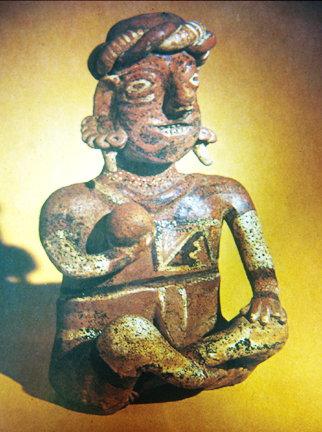
Seated figure of a ball player from Nayarit, Earthenware
Classic period, 500 CE
ART 198 - HISTORY OF WORLD CERAMICS
| The ritual ball game was a defining characteristic of Mesoamerican cultures, and dated back to Olmec times. Played on a long rectangular court with a heavy, solid rubber ball, the game had political and ritual significance. The players could use their elbows, hips, shoulders or knees, but not their hands. The heavily padded players would attempt to get the ball through a stone circle mounted 25 feet above the court, perpendicular to the floor. The playing court was approximately the size of a contemporary football field. The movements of the ball represented the movements of the celestial bodies such as the sun, moon, and stars. Captives in war were required to play the game, with the losers becoming sacrifices. This seated figure from Nayarit, in Western Mexico dates to the classic period, and is formed of burnished earthenware which has been painted in polychrome slips. The classic cultures of Western Mexico buried their dead in shaft tombs accompanied with a wide variety of ceramic grave offerings. The tombs were over 50 feet deep and were prepared in advance. Signs of reuse suggest they functioned as family crypts. Effigy figures of family members or servants were placed in tombs to accompany the deceased. The Nayarit specialized in figures painted in black, white, and yellow on a reddish ground. The subjects are men and women in naturalistic poses such as this ball player, shown holding the ball in his right hand. Other tombs have been found to contain complete representations of the ball game, with the court and all the players along with spectators in the stands formed in earthenware. | Seated figure of a ball player from Nayarit, Earthenware Classic period, 500 CE |
|
|